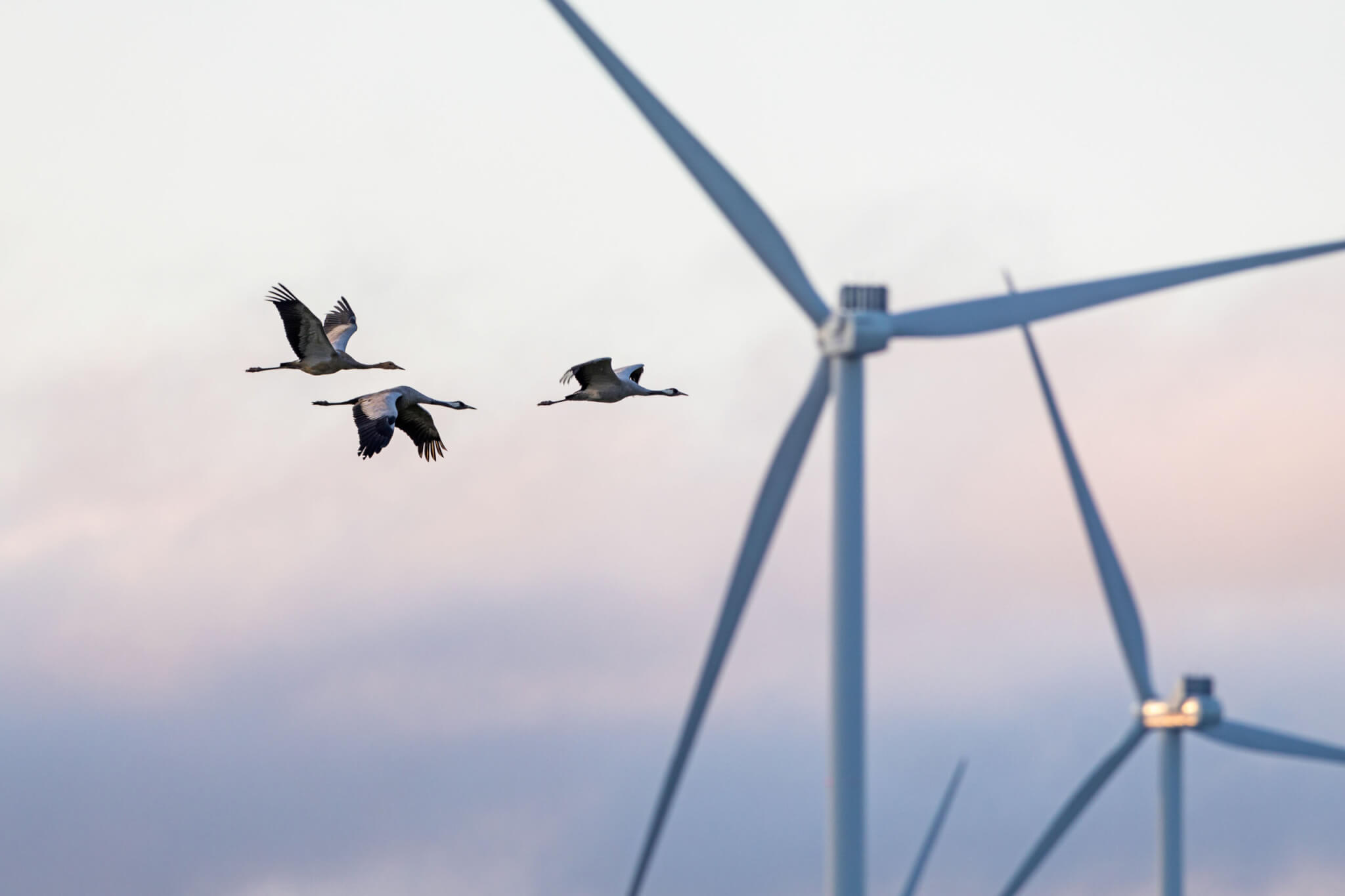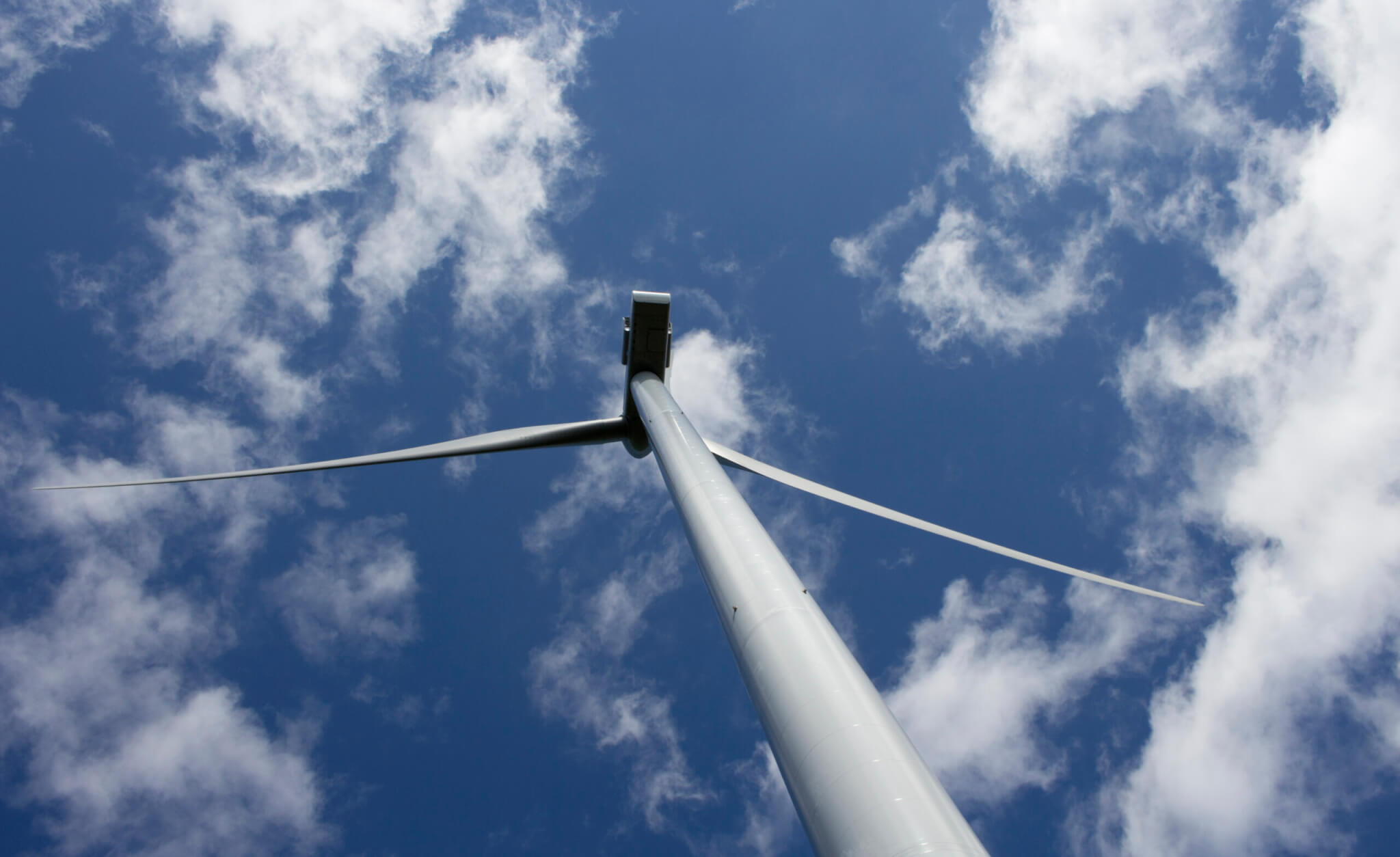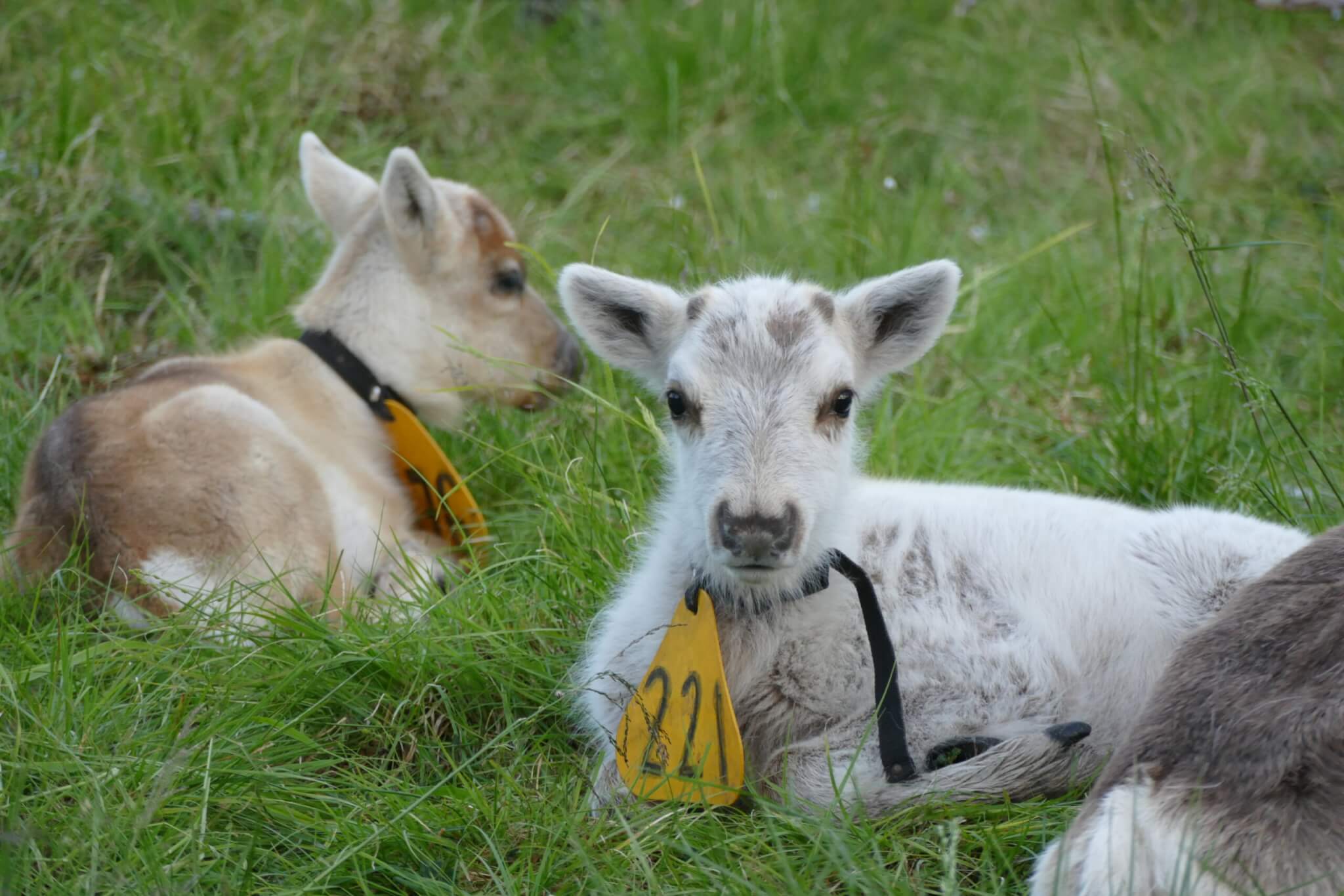Impacts on fauna and flora
The effects of the wind power project on the fauna are investigated, evaluated and accurately modeled during the planning of the wind power project. During project planning, it will also be determined whether there are endangered plants in the area.
Here you can find information about how wind power impact on flora and fauna.

Wind power and birds
The impacts of wind turbines on birds mainly come from the disturbing effect of the operating noise and the blade movement on nesting and searching for food, as well as from the risk of birds flying into the blades. The impacts depend on the size and number of wind turbines and their technical solutions and geographical location, the shape of the surrounding terrain, as well as on the composition of bird species in the region and the distances between turbines.
It is possible to prevent birds from flying into wind turbines, for example, with a bird radar. A bird radar has been installed in the first offshore wind farm in Finland, Tahkoluoto in Pori, collecting information about the behaviour and number of birds. The radar can also stop a turbine when a bird of an endangered species is flying towards it.
Radar observations carried out in Tahkoluoto have indicated that birds do not fly right past the wind turbines even if the birds have previously used that particular route. No changes have been observed in the total number of flights or in the direction where birds set off from nesting islets for hunting and where they are feeding. All in all, the impacts of wind turbines on birds would seem to be small and more minor than predicted.
Bird monitoring study
The summary of a Finnish bird monitoring study covering a period of several years was completed in summer 2019. The monitoring was carried out during spring and autumn migration in the area of onshore wind farms on the North-Eastern coast of the Bay of Bothnia. This area has a lot of wind power and is a significant migratory route for birds.
Based on the monitoring results, migratory birds primarily aim to avoid wind farms; therefore, the impacts of wind turbines on migratory birds and on the nationally important migratory routes of birds have remained low. No changes resulting from wind turbines were detected in the location of resting and feeding areas. Agricultural activities carried on in the area and the timing of their different work stages have a bigger impact on the location of areas that are useful for birds.
Modern wind turbines are spaced so far apart that they do not prevent bird movement even in the area of wind farms, and therefore the building of wind farms has not cut nationally important main migratory routes of birds even in migratory bottleneck areas. Based on implemented studies, the number of collisions of birds with wind turbines has remained clearly lower than estimated in the project planning stages and in environmental impact assessments (EIA). Actual verified collisions have mainly taken place among local species.
Extensive bird monitoring was carried out in the spring and autumn: a total of 324 field work days in the Simo and Ii regions and a total of 120 field work days in the Kalajoki and Pyhäjoki regions. In addition to the migration watch, birds that have flown into wind turbines were also sought in the monitoring. In the area of wind farms, surveys on nesting birds have been carried out and, for example, feeding flights of different species have been monitored.
The study was published in the BirdLife Finland yearbook 2018, and articles on the subject have been published in the Renewables Finland online magazine (in Finnish).
Wind power and large birds of pray
The need to protect the nesting sites of large birds of prey, such as white-tailed eagles, golden eagles, greater spotted eagles, ospreys, and northern eagle owls, as well as endangered medium-sized birds of prey, such as European honey buzzards and common buzzards, must be taken into account in the planning of wind power construction. According to previous guidelines, special requirements for studies concerning large birds of prey in the planning of wind power construction arise when the planning zone is located within about two kilometres of the nesting sites of large birds of prey and regular feeding areas in the winter period. However, the limit of two kilometres is not always sufficient. It is advisable on a case-by-case basis to investigate the impacts on an area wider than this as, in many cases, taking account of impacts over an area wider than two kilometres may have impacts on the prevention of harmful effects.
As of yet, there has been very little research data available concerning the impacts of wind turbines on large birds of prey in Finland. However, further information will be available over the next few years with regard to eagles as a result of the WINDLIFE project, which was launched in 2023 (see Chapter Land Mammals, https://www.luke.fi/en/projects/tuuliriista). In addition, in 2022 Metsähallitus published guidelines for the assessment of impacts on golden eagles in support of the planning of wind power projects. The Finnish-language publication includes examples that highlight good practices with regard to the impacts to be assessed in connection with wind power planning concerning golden eagles in the nesting areas. The methods have been compiled from actual impact assessments of wind power projects, added by further development.
The Centres for Economic Development, Transport and the Environment (ELY Centres) have knowledge of eagle nesting sites. Although this knowledge is confidential, an ELY Centre will provide wind power developers with preliminary information at an early stage whether there is a nest in the area. If there is a nest in the area or its vicinity, the ELY Centre will tell how close to the planned project area the nest is located, in which case the project operator can decide whether or not to go ahead with the project in the area.
If the ELY Centre has no knowledge of an eagle’s nest in the area, it is still possible to enquire from WWF whether the area is of the type that according to observations there may be a new nest, the accurate location of which may not be known yet to WWF or the ELY Centre. If this is the case, an eagle’s nest can be sought in the most likely places before investing in further surveys.
Review of impact on birds and bats
The Ministry of Economic Affairs and Employment commissioned a report on the impacts of wind power on birds and bats in 2017 (in Finnish). The impacts of wind turbines were assessed on the basis of international and domestic research literature and reports on impacts. According to the review, the number of birds and bats colliding with wind turbines varies a great deal between different species and sub-species. The siting of turbines plays a key part in the number of animal fatalities resulting from collisions.
On the basis of an estimate carried out by the Finnish Museum of Natural History for the Ministry of Economic Affairs and Employment, further construction of wind power is not likely to pose a significant threat to the bird and bat populations in Finland if the wind turbines are built in areas with a low density of species and where the likelihood of collisions is as low as possible. However, there is a need for further research in order to ensure that wind power construction will not pose a threat to the population sizes of species that are susceptible to collisions or disturbance.

Wind power and bats
In Finland, so far bat collisions have been studied to a lesser degree but based on observations, collisions seem to be quite rare although it is not possible to estimate turbine-specific fatalities due to the small amount of research data available. Bats are attracted to wind turbines, which may increase the risk of collision.
In addition to collisions, it is suggested that fatalities could also be caused by so-called barotrauma, i.e. ruptures in the bats’ lungs caused by a sudden change in air pressure behind a rotating blade. On the other hand, there are also research results indicating that only a small number of dead bats had signs of barotrauma, and therefore the significance of barotrauma in the wind turbine deaths of bats is still a disputable subject.
Based on research results, the harmful impacts of wind power on both birds and bats are smaller than the impacts of climate change and deterioration of the quality of habitats resulting from the burning of fossil fuels, wood, or peat. The impacts at the population level remain small with both species in comparison with the impacts of other human activities. (Ministry of Economic Affairs and Employment of Finland 2017)
Research
The University of Turku and the University of Helsinki published a study in 2023. on the impact of wind power on bats. The presence of bats was studied in large wind farms in the coastal areas of Western Finland. The analyses focused on the Northern bat (Eptesicus nilssonii) and the myotis, of which the most common in Finland are the Daubenton’s bat (Myotis daubentonii) and four other species.
The results of the study indicate that certain bat species avoid wind turbines. Both of the studied bat groups were nowhere to be seen near wind turbines. Northern bats were not found until at a distance of 800 metres from wind turbines, and with the myotis the distance may be even greater.
The study does not directly reveal the reason why there is a connection between the presence of bats and wind turbines. The avoidance may result from the wind turbines themselves or from wind turbine areas. In Finland, many wind turbines are built in forest areas and their construction requires an extensive road network. In addition, wind power areas form an opening in the forest.
According to studies, there is a need for further research because it is still not known why bats avoid wind turbine areas.
Review of impact on birds and bats
The Ministry of Economic Affairs and Employment commissioned a report on the impacts of wind power on birds and bats in 2017 (in Finnish). The impacts of wind turbines were assessed on the basis of international and domestic research literature and reports on impacts. According to the review, the number of birds and bats colliding with wind turbines varies a great deal between different species and sub-species. The siting of turbines plays a key part in the number of animal fatalities resulting from collisions.
On the basis of an estimate carried out by the Finnish Museum of Natural History for the Ministry of Economic Affairs and Employment, further construction of wind power is not likely to pose a significant threat to the bird and bat populations in Finland if the wind turbines are built in areas with a low density of species and where the likelihood of collisions is as low as possible. However, there is a need for further research in order to ensure that wind power construction will not pose a threat to the population sizes of species that are susceptible to collisions or disturbance.

Wind power and land mammals
There are a lot of observations of game animals and other mammals in wind farms. According to the observations, the use of wind turbines does not disturb their behaviour, but so far there are only a few research results on the impacts of wind power on land mammals in Finland. In places, the improved road network has enhanced the conditions for hunting, but it is not a question of a direct impact of wind power on the living conditions of mammals.
WINDLIFE project
The Natural Resources Centre Finland (Luke) has launched the project The occurrence of forest animals and use of habitats in the vicinity of wind power areas (WINDLIFE), which is to be implemented in 2023-2028 with joint funding from Luke and 14 wind power companies. During the five-year monitoring project, Luke will investigate the impacts of wind power on wolves, Finnish forest reindeer, and eagles. As directive species, they must be given special attention in the planning of wind power and other land use. Directive species are so-called species of Community interest selected from the EU area, as referred to in the Annexes of the Habitats Directive and the Birds Directive, as well as their habitats.
The project also studies the impacts of wind power on reindeer and reindeer husbandry, and on the costs of reindeer husbandry. Furthermore, impacts on deer and hunting will be investigated with the aid of data recorded on hunting events and surveys. The objective of the project is to increase knowledge and produce guidelines to be able to take the habitat requirements of the species now under review into account even better in the siting of wind turbines.
Reindeer
When planning wind farms in Lapland, the views of the reindeer-owners’ associations are heard in the siting of wind turbines, as just over one-third of Finland’s land area is a reindeer management area. Reindeer husbandry is based on the free grazing right and extensive harmonised grazing areas. Other forms of land use pose a threat to the future of reindeer husbandry because they reduce and fragment grazing areas and disturb grazing peace. At the same time, there is a lot of pressure to install wind power in the entire area of Finland, also in the north in the reindeer management area, due to the need to increase Finland’s energy self-sufficiency and carbon-neutral electricity production.
Reindeer husbandry and the wind power sector have joined forces in accepting the challenge and drawing up an operating model (in Finnish) on the best practices to take reindeer husbandry into account in the different phases of the life cycle of a wind power project, from the tentative investigations in the initial stage to the completion of the production phase. It is key to build and maintain trust and good interaction from as early as possible. There are differences in the reindeer husbandry methods, for example, between southern and northern areas and between individual reindeer owners’ associations. There are also differences in Finland’s methods of reindeer husbandry compared to other countries. Therefore, it is important to learn about the local operating environment.

Underwater habitat and fish
The most significant impacts of offshore wind power on the underwater habitat take place in the construction phase. Impacts during operation are usually low, especially if there are other operations nearby, such as a port or a shipping channel.
Underwater foundations create an artificial reef for fauna and flora. This may improve the living conditions of some species and living cycles. According to a study carried out in the area of an offshore wind farm in Denmark, especially mussels attach themselves onto the foundations of the wind farm, and the amount of fish and other fauna and flora increased.
The above-mentioned reef impact may create a new habitat for some fish species. On the other hand, during the construction stage, spawning areas can be destroyed either temporarily or permanently. The construction of an offshore wind farm is scheduled so that the impacts on fish spawn will remain as small as possible.
In offshore wind power projects, the zoobenthos is adversely affected by the installation of undersea cables, but the situation is normalised rapidly after the installation stage, and corresponding zoobenthos quickly grows in the area again. The magnetic field caused by the cable is estimated to be larger than the natural geomagnetic field only at the distance of up to one metre from the cable at the most. Therefore, the magnetic field of the cable probably does not have significant harmful impacts on the fauna. [1]
Sources:
SEAS Distribution A.m.b.A., 2000. Havmøllepark ved Rødsand.Vurdering af Virkninger på Miljøet – VVM-redegørelse.July 2000.